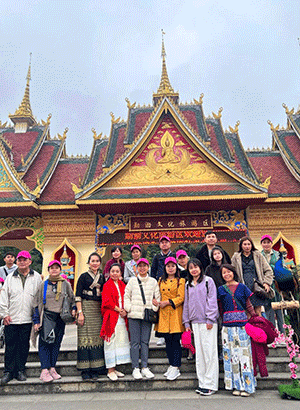Laos-China Railway driving tourism growth
Leisure travel between Laos and China is growing exponentially thanks to the Laos-China Railway, with Chinese travellers coming to Laos in large numbers and many Lao people visiting China, forming the bulk of passengers on the railway.
 |
| The Laos-China Railway. |
The Chairman of the Lao-Chinese Cultural Tourism Promotion Association, Mr Saly Phimphinith, recently gave an exclusive interview to the Vientiane Times, providing insights into Laos-China tourism trends and the challenges that need to be overcome.
What is the current trend of Laos-China tourism in general?
The Chinese are now the third-largest group of visitors to Laos, after people from Thailand and Vietnam. In 2019, the number of Chinese visitors was recorded at 1,022,727, accounting for 20 percent of all foreign tourists. The surge in numbers was attributed to the proximity of Laos to China and the availability of direct flights from several major Chinese cities to Laos.
In 2023, the number was recorded at 641,314, while in the first three months of 2024 the figure was 242,404, an increase of 69 percent compared to the same period in 2023, when 143,312 Chinese visitors were recorded. In addition, the total number of foreign tourists in the first three months of 2024 was 1,133,447, an increase of 36 percent compared to the same period in 2023.
How about the figures since the Laos-China Railway came into service?
The railway began operating in Laos in December 2021, initially carrying passengers only through Laos. Then in 13 April 2023 it began a cross-border service between Laos and China, which fuelled a marked growth in passenger numbers. This was followed by the launch of services between Vientiane and Kunming, which again bumped up tourist numbers. In November 2023, the first train for tourists running between Vientiane and Beijing and in September 2023 a new electrified train arrived in Vientiane to accommodate the increasing demand.
The operation of six regular train services a day, comprising five within Laos and one to Kunming, has sparked further tourism growth. From December 3, 2021, to April 7, 2024, a total of 5,069,080 Lao nationals travelled on the Laos-China Railway, including 172,203 cross-border passengers.
 |
| Lao tourists visit Sisongphanna after travelling on the Laos-China Railway. |
 |
| Mr Saly Phimphinith. |
From early 2024 to April this year, 1,038,050 domestic travellers used the railway. The number of cross-border passengers was recorded at 61,241, with Lao nationals travelling to China recorded at 31,015, averaging 316 each day, while the number of passengers coming to Laos from China was registered at 30,226, averaging 308 each day.
What attracts Chinese tourists to Laos and what can be done to make Laos more appealing?
The Chinese like Laos’ natural beauty and its cultural and historical attractions, especially the waterfalls and rivers in Luang Prabang, Vientiane and other provinces. I think we could offer more in the way of night-time entertainment such as traditional dance performances and other shows at restaurants and museums in Luang Prabang and during river cruises. These should be tailored to Chinese tastes.
 |
I also think more nature-based tourism would be popular, with a focus on environmental protection, particularly in relation to forests, watersheds and wildlife. In the past, forest treks and the wild elephants in Phou Khaohaouy National Park used to be popular but these activities have been impacted by deforestation and other environmental damage.
To make Laos more appealing to the Chinese, it is essential to enhance the overall tourism experience. This includes offering more cultural attractions, improving transport infrastructure, and providing diverse and attractive tour packages.
What are the main challenges for Lao-Chinese tourism and what solutions would you suggest?
The main issue in Laos is budgetary constraints. Limited resources mean we are unable to provide sufficient amenities. For instance, there is a dearth of signage in the Chinese language at tourist sites, making it difficult for visitors to understand what they are seeing and limiting their enjoyment.
In addition, the lack of Chinese-speaking tour guides with comprehensive cultural and historical knowledge is another obstacle. Improvements in transportation infrastructure are also necessary, as it takes a long time to get to many tourist attractions, which involves higher costs compared to neighbouring countries. Proper management of waste is another important issue that needs attention.
Most Chinese coming to Laos are first-time visitors and their impression is very important. Positive experiences can lead them to recommend Laos to others, while negative encounters can have far-reaching implications for Laos’ tourism industry.
Additionally, global economic impacts have raised travel costs, creating a risk for zero-dollar tours, with tour operators in China offering low prices and receiving commissions from businesses in the destination country.
The strong competition between Lao and Chinese tour companies means that a high standard of service must be provided. This may result in Lao companies struggling to adapt and potentially degrading their services in the interests of cost-cutting, thereby tarnishing the image of Lao tourism. In the long term, Laos should aim to provide high-quality services tailored to high-end Chinese tourists.
To address these challenges, it is imperative for tourism-related businesses, including tour companies, hotels, restaurants, gift shops, and transport operators, as well as tourism associations like the Lao-Chinese Cultural Tourism Promotion Association, to hold regular meetings and workshops.
These platforms should be utilised to discuss and collaboratively solve the issues we face. Establishing strong connections with related government sectors and fostering close ties with Chinese counterparts at the city, district, provincial and national levels is also crucial in overcoming these challenges.
ByKeoxomphou Sakdavong
(Latest Update June 24, 2024)
|





